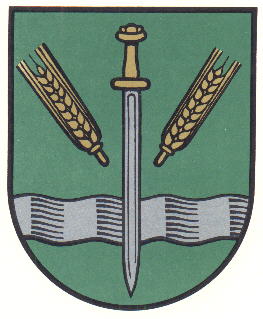Sievern: Difference between revisions
Jump to navigation
Jump to search
Knorrepoes (talk | contribs) No edit summary |
Knorrepoes (talk | contribs) m (Text replace - "[[Literature" to "{{media}} [[Literature") |
||
| Line 18: | Line 18: | ||
====Origin/meaning==== | ====Origin/meaning==== | ||
The wavy bar refers to the Aue stream in the municipality. The sword is a symbol of the Karolingan Estate or Pippinsburg in the municipality, and is based on a sword found in an excavation near the village. The two wheatears are a symbol of the agriculture, the main source of income in the municipality. | The wavy bar refers to the Aue stream in the municipality. The sword is a symbol of the Karolingan Estate or Pippinsburg in the municipality, and is based on a sword found in an excavation near the village. The two wheatears are a symbol of the agriculture, the main source of income in the municipality. | ||
{{media}} | |||
[[Literature]] : Wappen des Landkreises Wesermünde, 1973 | [[Literature]] : Wappen des Landkreises Wesermünde, 1973 | ||
Revision as of 06:03, 9 July 2014
| Heraldry of the World Civic heraldry of Germany - Deutsche Wappen (Gemeindewappen/Kreiswappen) |
SIEVERN
State : Niedersachsen
District (Kreis) : Cuxhaven (until 1977 Wesermünde)
Incorporated into : 1974 Langen
Official blazon
Origin/meaning
The wavy bar refers to the Aue stream in the municipality. The sword is a symbol of the Karolingan Estate or Pippinsburg in the municipality, and is based on a sword found in an excavation near the village. The two wheatears are a symbol of the agriculture, the main source of income in the municipality.
Contact and Support
Partners:
Your logo here ?
Contact us
© since 1995, Heraldry of the World, Ralf Hartemink 
Index of the site
Literature : Wappen des Landkreises Wesermünde, 1973











